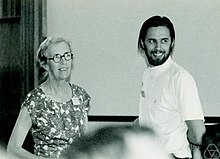Mary Cartwright
Dame Mary Lucy Cartwright (born December 17, 1900 in Aynho in Northamptonshire , † April 3, 1998 in Cambridge ) was an English mathematician who dealt with function theory and differential equations .
life and work
Cartwright began in 1919 at St Hugh's College of Oxford University her study of mathematics, where they among others Godfrey Harold Hardy studied. In 1923 she graduated there with top marks. She then worked for a while as a school teacher at Alice Ottley School in Worcester and Wycombe Abbey School in Buckinghamshire before returning to Oxford in 1928, where she received her PhD from Hardy and (when he went to Princeton) from Edward Charles Titchmarsh in 1930 with a Work on the zeros of whole functions. Her examiner was John Edensor Littlewood , with whom she later worked closely. In 1930 she was a Yarrow Research Fellow at Girton College , Cambridge, where she attended lectures by Littlewood and solved one of the problems he posed (Cartwright's theorem about the maximum amount of an analytic function that takes values in the unit disk at most times).
In 1934 she was on the recommendation of Littlewood and Hardy Assistant Lecturer, 1935 Lecturer and 1936 Director of Studies at Girton College.
In 1938 she began her long collaboration with Littlewood on nonlinear differential equations, which arose from a request from the Radio Research Board in cooperation with electromagnetic problems (radio waves, radar). In doing so, they discovered that the solutions were very sensitive to small changes in the initial conditions, which was later popularized in chaos theory as the “butterfly effect ”. In 1948 she became Mistress of Girton College and in 1959 she also became a reader in functional theory, which she remained until her retirement in 1968. After that she often took on visiting professorships, for example in 1968/69 at Brown University and 1969/70 in Poland .

In 1947 she was accepted (as the first mathematician) as a member (" Fellow ") in the Royal Society . She was also on the Council of the Royal Society from 1955 to 1957 and received their New Year's Eve Medal in 1964 . 1961/62 she was President of the London Mathematical Society , whose De Morgan Medal she received in 1968. In 1968 she was elected an Honorary Fellow of the Royal Society of Edinburgh . In 1969 she was ennobled by the British Queen as Dame Commander of the Order of the British Empire (DBE) and since then has had the addition of " Dame ".
literature
- Freeman Dyson : Mary Cartwright. In: Nina Byers, Gary Williams: Out of the Shadows: Contributions of 20th Century Women to Physics. Cambridge University Press, 2006.
- Donald J. Albers, Gerald L. Alexanderson Fascinating Mathematical People: Interviews and Memoirs , Princeton University Press 2011
supporting documents
- ^ Entry on Cartwright; Lady; Mary Lucy (1900-1998) in the Archives of the Royal Society , London
- ↑ Fellows Directoty. Biographical Index: Former RSE Fellows 1783–2002. Royal Society of Edinburgh, accessed October 16, 2019 .
Web links
- Cartwright at the Mathematics Genealogy Project
- John J. O'Connor, Edmund F. Robertson : Mary Cartwright. In: MacTutor History of Mathematics archive .
- Biography at Agnes Scott College
| personal data | |
|---|---|
| SURNAME | Cartwright, Mary |
| ALTERNATIVE NAMES | Cartwright, Mary Lucy |
| BRIEF DESCRIPTION | English mathematician |
| DATE OF BIRTH | 17th December 1900 |
| PLACE OF BIRTH | Aynho |
| DATE OF DEATH | April 3, 1998 |
| Place of death | Cambridge |

